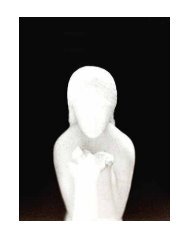Odds and Ends Essays, Blogs, Internet Discussions, Interviews and Miscellany
Collected essays, blogs, internet discussions, interviews and miscellany, from 2005 - 2020
Collected essays, blogs, internet discussions, interviews and miscellany, from 2005 - 2020
Create successful ePaper yourself
Turn your PDF publications into a flip-book with our unique Google optimized e-Paper software.
He also acknowledges the retrograde tendencies inherent in Modernist poetry-tendencies that arguably have their
genesis in Romantic roots. Quoting Amy Lowell’s six attributes of Imagist poetry, listed in her anthology Some Imagist
Poets, Motion writes:
The fact that these aims are sufficiently indeterminate to describe not only Thomas but a wide variety of
authors suggests that strict Imagists were not espousing entirely new principles, but isolating a number
of old ones and thereby making them seem unfamiliar. Imagism, inother words, is a matter of selection
and amplification. The same can also be said of full-fledged Modernism, which shares many of its
strategies. 76
Indeed, Thomas approved of Pound’s Personae because unlike the florid style of the late Victorians it contained ‘no
golden words shot with meaning; a temperate use of images and none far fetched’. 77 Thomas’s praise for what can
only be described as a Wordsworthian plainness of speech contributes to a confirmation of the largely unbroken link
between the old and the “new” poetic, which Pound and Lowell failed to recognise. It is appropriate that such praise
should come from a poet whose poetic aesthetic prompted him to write in defence of it: ‘A poem of the old kind has a
simple fundamental meaning which every sane reader can agree upon; above and beyond this each one builds as he can
or must’. 78 As we have seen, Pound would have agreed with such a view.
In this essay I have attempted to show that the poetic ideas of Ezra Pound have similarities to the poetic ideas of
William Wordsworth, especially with regard to Wordsworth’s advocating a naturalistic and descriptive mode of
poetic writing that became the principal style of poetry for the rest of the nineteenth century and the greater part of
the twentieth. Additionally, the essay has argued that the received opinion that Pound’s poetical radicalism was
largely motivated by his antipathy to Romantic poetry is somewhat exaggerated. Rather his radicalism was the result
of his reaction to the stylistic excesses of late Victorian poetry, and as such can be paralleled with Wordsworth’s
reaction to the stylistic excesses of late seventeenth-century poetry. To this extent, Pound’s poetic ideas can be seen
as a continuation of certain Romantic ideals in poetry; ideals primarily articulated by Wordsworth, having been
developed from seventeenth-century empiricist philosophy.
Notes
1. Anthony Easthope, ‘How Good is Seamus Heaney?’, English, 46. 184, (1997), 21-36 (p.21).
2. Easthope, p.21.
3. Easthope, p.21.
4. Melvin Rader, Wordsworth: A Philosophical Approach (Oxford: Clarendon Press, 1967), p.115.
5. J. A. Appleyard, Coleridge’s Philosophy of Literature: The Development of a Concept of Poetry (Cambridge MA: Harvard
University Press, 1965), p.67.
6. Robert Langbaum, The Modern Spirit: Essays on the Continuity of Nineteenth and Twentieth-Century Literature (London: Chatto
and Windus, 1970), p.18.
7. Langbaum, p.20.
8. David B. Pirie, William Wordsworth: The Poetry of Grandeur and Tenderness (London: Methuen,1982), p.1.
9. Geoffrey Clifford Jaggs, ‘Techniques of Truth in the Poetry of William Wordsworth and Ezra Pound’
(doctoral thesis, University of Leeds, 2002), p.121.
10. Preface to Lyrical Ballads, ed. by R. L. Brett and A. R. Jones (London: Methuen, 1963), p. 245.
11. The Letters of William and Dorothy Wordsworth, ed. by E. de Selincourt, 2nd edn, rev. by C. L. Shaver, 6 vols (Oxford: Oxford
University Press, 1935-1939), p.641.
12. The Poetical Works of William Wordsworth, ed. by T. Hutchinson and E. de Selincourt (London: Oxford University Press, 1936),
Wordsworth Editions 1994, p.10.
13. The Prose Works of William Wordsworth, ed. by W. J. B. Owen and Jane Worthington Smyser, 3
vols (Oxford: Clarendon Press, 1974), I, p.123.
14. Geoffrey Thurley, The Romantic Predicament (London: Macmillan, 1983), p.69.
15. The Poetical Works of Samuel Taylor Coleridge, ed. by J. D. Campbell (London: Macmillan, 1938), p.93.
16. F. R. Leavis, Revaluation: Tradition and Development in English Poetry (London: Chatto &
Windus, 1956), p.206.
17. Edward Larrissy, ‘Modernism and Postmodernity’, in Romanticism: An Oxford Guide, ed. by Nicholas Roe (Oxford: Oxford
University Press, 2005), pp.665-74 (p.665.).
18. Larrissy, Roe, Romanticism, p.666.
19. Irving Babbitt, Rousseau & Romanticism (Austin: University of Texas Press, 1919, 1947, 1977) p.280.
20. George Bornstein, Romantic and Modern: Revaluations of Literary Tradition (Pittsburgh: University
of Pittsburgh Press, 1977), p.8.
17




